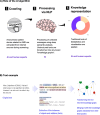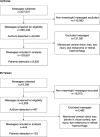Real-world insights of patient voices with age-related macular degeneration in the Republic of Korea and Taiwan: an AI-based Digital Listening study by Semantic-Natural Language Processing
- PMID: 40102785
- PMCID: PMC11916980
- DOI: 10.1186/s12911-025-02929-5
Real-world insights of patient voices with age-related macular degeneration in the Republic of Korea and Taiwan: an AI-based Digital Listening study by Semantic-Natural Language Processing
Abstract
Background: In this era of active online communication, patients increasingly share their healthcare experiences, concerns, and needs across digital platforms. Leveraging these vast repositories of real-world information, Digital Listening enables the systematic collection and analysis of patient voices through advanced technologies. Semantic-NLP artificial intelligence, with its ability to process and extract meaningful insights from large volumes of unstructured online data, represents a novel approach for understanding patient perspectives. This study aimed to demonstrate the utility of Semantic-NLP technology in presenting the needs and concerns of patients with age-related macular degeneration (AMD) in Korea and Taiwan.
Methods: Data were collected and analysed over three months from January 2023 using an ontology-based information extraction system (Semantic Hub). The system identified patient "stories" and extracted themes from online posts from January 2013 to March 2023, focusing on Korea and Taiwan by filtering the geographic location of users, the language used, and the local online platforms. Extracted texts were structured into knowledge graphs and analysed descriptively.
Results: The patient voice was identified in 133,857 messages (9,620 patients) from the Naver online platform in Korea and included internet chat forums focused on macular degeneration. The most important factors for AMD treatments were effectiveness (1,632/3,401 mentions; 48%), price and access to insurance (33%), tolerability (10%) and doctor and clinic recommendations (9%). Treatment burden associated with intravitreal injection of vascular endothelial growth factor inhibitors related to tolerability (254/942 mentions; 27%), financial burden (20%), hospital selection (18%) and emotional burden (14%). In Taiwan, 444 messages were identified from Facebook, YouTube and Instagram. The success of treatment was judged by improvements in visual acuity (20/121 mentions; 16.5%), effect on oedema (10.7%), less distortion (9.1%) and inhibition of angiogenesis (5.8%). Tolerability concerns were rarely mentioned (26/440 mentions; 5.9%).
Conclusions: Digital Listening using Semantic-NLP can provide real-world insights from large amounts of internet data quickly and with low human labour cost. This allows healthcare companies to respond to the unmet needs of patients for effective and safe treatment and improved patient quality of life throughout the product lifecycle.
Keywords: Digital; Macular degeneration; Natural language processing; Patient voice; Real-world data; Semantics/semantic analysis; Social media; Tolerability; Unmet needs.
© 2025. The Author(s).
Conflict of interest statement
Declarations. Ethics approval and consent to participate: Ethics approval for this study and a waiver of consent was provided by the Kangwon National University Institutional Review Board (approval KWNUIRB-2025–05-001) and the study adhered to the principles of the Declaration of Helsinki. This study complied with EU General Data Protection Regulation (GDPR), as well as local Korean and Taiwanese privacy regulations. Patient consent was not required as no individual patient data are presented. Competing interests: HJ, OC, HY, YLN, YYL, and DM are employees of Roche who funded this study, and they own stocks in Roche. IE is one of the shareholders and executives of Semantic Hub, which received funding from Roche to perform this study. SY has no competing interest to declare.
Figures






Similar articles
-
Educational and Emotional Needs of Patients with Myelodysplastic Syndromes: An AI Analysis of Multi-Country Social Media.Adv Ther. 2023 Jan;40(1):159-173. doi: 10.1007/s12325-022-02277-0. Epub 2022 Sep 22. Adv Ther. 2023. PMID: 36136244 Free PMC article.
-
[What worries people with multiple sclerosis in Russia? Semantic analysis of patient messages using artificial intelligence tools].Zh Nevrol Psikhiatr Im S S Korsakova. 2022;122(7. Vyp. 2):78-83. doi: 10.17116/jnevro202212207278. Zh Nevrol Psikhiatr Im S S Korsakova. 2022. PMID: 35912561 Russian.
-
Anti-vascular endothelial growth factor for neovascular age-related macular degeneration.Cochrane Database Syst Rev. 2019 Mar 4;3(3):CD005139. doi: 10.1002/14651858.CD005139.pub4. Cochrane Database Syst Rev. 2019. PMID: 30834517 Free PMC article.
-
The Growing Impact of Natural Language Processing in Healthcare and Public Health.Inquiry. 2024 Jan-Dec;61:469580241290095. doi: 10.1177/00469580241290095. Inquiry. 2024. PMID: 39396164 Free PMC article. Review.
-
Real-World Effectiveness and Real-World Cost-Effectiveness of Intravitreal Aflibercept and Intravitreal Ranibizumab in Neovascular Age-Related Macular Degeneration: Systematic Review and Meta-Analysis of Real-World Studies.Adv Ther. 2020 Jan;37(1):300-315. doi: 10.1007/s12325-019-01147-6. Epub 2019 Nov 14. Adv Ther. 2020. PMID: 31728825 Free PMC article.
Cited by
-
Septic Shock in Hematological Malignancies: Role of Artificial Intelligence in Predicting Outcomes.Curr Oncol. 2025 Aug 10;32(8):450. doi: 10.3390/curroncol32080450. Curr Oncol. 2025. PMID: 40862819 Free PMC article. Review.
References
-
- Wong WL, Su X, Li X, Cheung CM, Klein R, Cheng CY, et al. Global prevalence of age-related macular degeneration and disease burden projection for 2020 and 2040: a systematic review and meta-analysis. Lancet Glob Health. 2014;2(2):e106–16. - PubMed
-
- Song MY, Kim Y, Han K, Kim JH. Prevalence and Risk Factors of Age-Related Macular Degeneration in South Korea: Korea National Health and Nutrition Examination Survey. Ophthalmic Epidemiol. 2024;32(1):34–43. 10.1080/09286586.2024.2321892. - PubMed
-
- Thomas CJ, Mirza RG, Gill MK. Age-Related Macular Degeneration. Med Clin North Am. 2021;105(3):473–91. - PubMed
-
- Schmidt AL, Rodriguez-Esteban R, Gottowik J, Leddin M. Applications of quantitative social media listening to patient-centric drug development. Drug Discov Today. 2022;27(5):1523–30. - PubMed
MeSH terms
LinkOut - more resources
Full Text Sources
Medical

